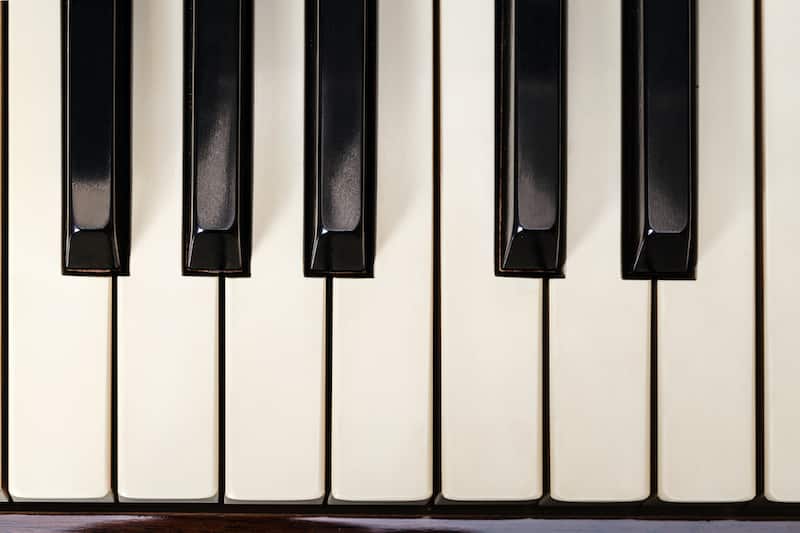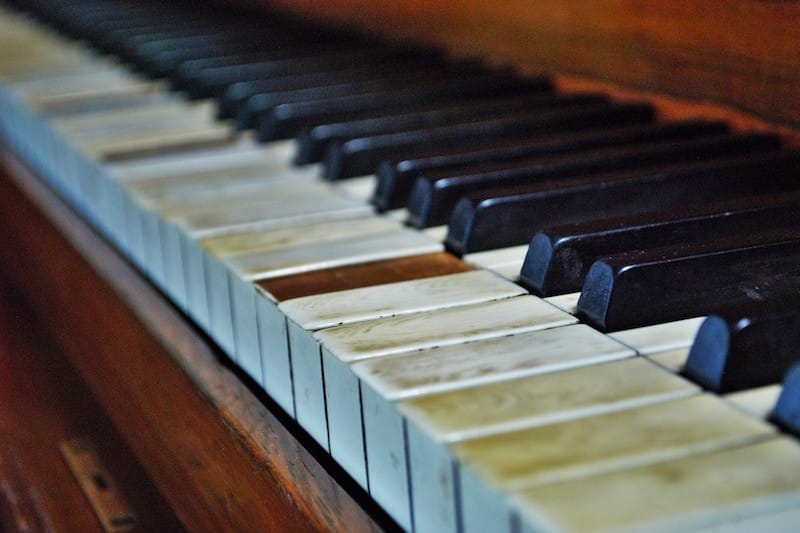The piano is a complexly constructed instrument made up of many parts. Among these components are the pieces that are interacted with the most: the keys. The piano keys aren’t the most intricate part of the instrument, but they have a fascinating history when it comes to their construction and materials used. Knowing what your keys are made of can prove to be useful for identifying when it comes to maintaining and cleaning them as well as replacing them.
In this post, we’re going to look at what piano keys are made of and how to tell what material your keys use.
A Brief History of Piano Key Materials

Although nowadays, various instrument brands can use different materials to create their piano keys, there wasn’t as much choice in the past.
The first piano keys started out being made from entirely from wood.
As time passed and people started to develop the piano more and more, they started developing different materials to use to cover the keys.
Let’s look at how it’s changed over the years.
Keys on the First Pianos
The first piano, or the pianoforte as it was originally called, was invented around 1700AD by Bartolomeo Cristofori in Italy.
The design of the piano was inspired by its predecessor: the harpsichord, another type of keyboard instrument from the renaissance music period that was made almost entirely from wood, including its keys.
When the piano first entered the market, its keys were also made only of wood but it would use woods of different colors to highlight the white and black keys.
The Introduction of Ivory

Over the following years, instrument makers developed the piano extensively with one such development being to use different materials on the tops and fronts of piano keys.
They began to use Ivory from Elephant tusks on the keytops of the white keys as it was a material that didn’t wear as easily.
As well as its durability, ivory made the piano look more elegant and felt nicer to play than wood.
Thankfully, no one makes piano keys out of ivory in the US due to the increased demand for poaching elephants to the point where it became an endangered species.
You can still get pianos made with ivory keys but they are obtained legally.
Even though this material is banned from international trade, that doesn’t mean that owning a piano with ivory keys is against the law.
But, understandably, some pianists choose to boycott pianos made with this material because of its gruesome origin.
Ebony
Although the white keys were made from ivory, the black keys on a piano were often made from ebony which is dense dark hardwood.
They were sometimes made of other kinds of darker woods, including spruce, sugar pine, and basswood.
Unlike ivory, it isn’t illegal and doesn’t directly harm any animals when harvested so ebony is still used to this day.
Plastic

As ivory became illegal, piano corporations started switching to making their keys out of plastic.
That includes both the white keys and black keys.
Now, plastic has become the typical material used to make pianos and virtually no new pianos nowadays make their keys out of ivory.
However, some companies use alternative materials to make the keys look and feel like ivory.
There are some contrasting factors between owning a piano with plastic and ivory keys.
Ivory vs. Plastic Keys: What’s the Difference?
Pianists have expressed that playing on ivory keys feels different from those made with plastic keys.
Whichever is best to use is entirely subjective but they make no difference to the sound quality or tone of the instrument.
A common question is how do you know if your piano keys are ivory of plastic?
The first thing to check is the date that your piano was made.
Ivory was banned in the US in 1970s and so if your piano was made after that it’s unlikely to be made using ivory.
Equally, if it’s from before 1970 there’s a chance that it does have ivory keys but not definitely.
The main giveaway of ivory keys is that they tend to have a line where the stem and the key top join running through the keys at the base of the black keys.

This is the easiest way to tell if your keys are made of ivory as only the key top was made of ivory, not the stem of the key.
Another sign that your keys are made of ivory is that since they’re porous, they can get dirty more easily and can be challenging to clean.
Ivory keys also tend to turn yellow over time, whereas plastic keys only lose their coloring if they’re exposed to direct sunlight.
As mentioned earlier, pianos made today are almost always made from plastic or an imitation ivory material called Ivorite.
Plastic keys are very accessible, affordable, and durable whereas ivory keys can crack and chip over time.
But, the ivory’s porous nature absorbs sweat, allowing your fingers to glide across the keys with very little resistance.
That’s just one of the many reasons why professionals prefer this material over plastic.
Can You Get Replacement Ivory Keys?

You can, but it’s not that easy.
Your best chance is to reach out to a local piano tuner who might have some extra ivory keys lying around somewhere because some people ask to have their ivory keys replaced with plastic.
Even if you manage to obtain some spare ivory keys, they might look noticeably different from the ones on your piano.
More specifically, other ivory keys can have contrasting colors, patterns, and even sizes as each one is unique.
The chances of you getting matching parts are slim, and you might have to replace the entire keyboard with plastic if multiple keys are damaged.
You can use a different-looking ivory key that fits, but it might be distracting while you play.
Summing up Piano Key Materials
We hope that clears up some of your questions about what materials piano keys are made of.
Nowadays, most people purchasing a new piano will opt for a digital one rather than their acoustic counterparts.
Regardless, any modern versions of this instrument are highly likely to have plastic keys and if you have an old piano made some time before the 1970s, it might have ivory keys.
Being able to distinguish between the two can be useful when it comes to cleaning piano keys.

